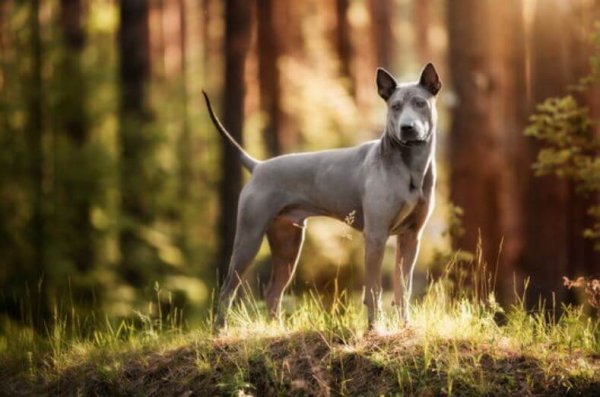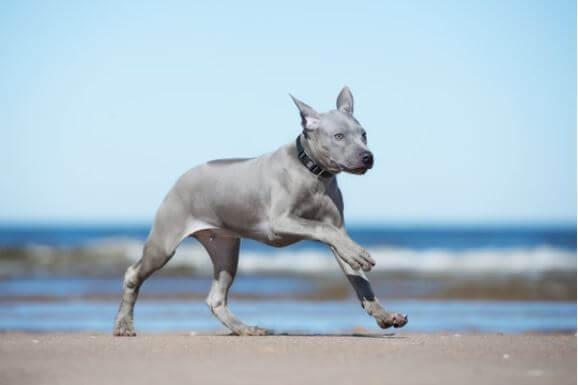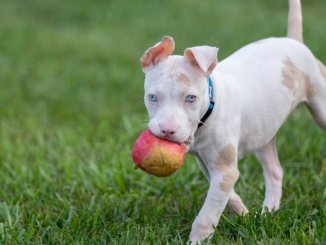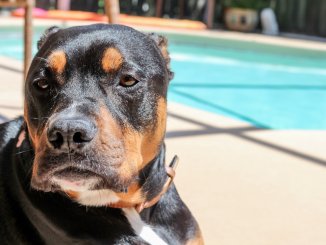The Thai ridgeback is a medium to large-sized, purebred hound dog of Thai origin.
Thai ridgebacks are intelligent dogs that are full of energy and make loyal family pets. They are also one of three breeds with a special coat that has a ridge of hair on its back that goes in the opposite direction of their coats.
Thai ridgebacks also lack an undercoat, so they shed less than most dogs and are low maintenance. However, because they lack an undercoat, they are not suitable for colder climates.
Thai ridgebacks typically cost $1,000 to $3,000 USD.
TABLE OF CONTENTS
What is a Thai Ridgeback?

From Adobe Stock
The Thai Ridgeback is a breed originating in Thailand, as a medium-sized pariah-type dog. Pariah dogs were half-wild dogs that were not owned by humans but rather roamed near human communities throughout Asia. While there are numerous hypotheses regarding the ancestors of this breed, many researchers believe it is a mutation that started in Asia or Africa. That is due to the unique ridge of fur along its backbone, which only two other breeds in the world have – the Rhodesian Ridgeback from Africa and the Phu Quoc Ridgeback from Vietnam,
The Thai Ridgeback probably descended from the Funan Ridgeback dog, as long as 1000 years ago. Thai documents written 360 years ago mention this dog as one used for hunting rats, wild boars, and cobras. Until today, a purebred Thai Ridgeback will confront and kill a cobra if given the opportunity. The Thai Ridgeback was also used as a guard dog, and for pulling carts. It remained a pure breed for centuries, due to the remote location where it lived in the Eastern part of the country.
This breed was not well known in the Western world until an American named Jack Sterling discovered four of the dogs on a visit to Thailand in 1994. After locating local breeders, Sterling purchased two females named Bent and Navinee, and a five-month-old male pup called Sakorn. He brought the dogs home to San Francisco and began breeding Thai Ridgebacks in the US. By 1997 this breed was recognized by the American Kennel Club, and in 2003 Sterling returned to Thailand to continue breeding the dogs there.
Due to its primitive background and relative isolation from other dogs for centuries, the Thai Ridgeback still retains many of its “wild” characteristics. On the one hand, it is healthy, strong, and intelligent. On the other hand, it can sometimes be difficult to train. This dog will have a lifelong struggle over wanting to listen to its owner and wanting to run far and fast in search of prey.
Temperament
Thai Ridgebacks are independent dogs who do not need to be part of a pack to feel confident. They enjoy living with humans and will respect and respond to an authoritative owner, but no matter how consistent and serious you are in your relationship with him, your Thai Ridgeback will never stop testing the limits you set for him.
While Thai Ridgebacks are extremely protective, they are the type of dog to pick fights or display aggression without reason. However, it is important to socialize your Thai Ridgeback from an early age, and as often as possible, to people and other dogs. You need to teach him proper manners for living in society, otherwise, he will choose himself when to be friendly and when to revert to his instinctual, natural behavior.
If you are able to integrate your Thai Ridgeback into your family unit and routine from the time he is a puppy, he will acclimate himself to your lifestyle and will be a loving and loyal pet.
Appearance
With sleek, muscular limbs and body, the Thai Ridgeback is extremely energetic and agile. His head is wedge-shaped, and his ears are triangular and stand straight up. The tail stands rigid and is called a sword or sickle tail. The back forms a straight, sturdy line. His upper and lower jaws interlock when he closes his mouth, giving him a “scissor jaw”. This is the healthiest bite for dogs that hunt. Dogs with overbites or underbites often suffer from dental problems as they age. The Thai Ridgeback has attractive almond-shaped eyes, and a short, neat coat. A ridge of fur on its back (growing in the opposite direction of the rest of its coat) makes it stand out among other similar looking breeds.
All of these traits give the Thai Ridgeback a regal, poised look. This is not the kind of dog you would call “cute” or “sweet”. But neither is he frightening or unpredictable looking in the way he moves and holds himself.
Thai Ridgeback Weight and Size
The Thai Ridgeback is a medium-sized dog. Males stand at 22-24 inches (56-61 cm) at the shoulder, and females are slightly smaller at 20-22 inches (51-56 cm). Males weigh an average of 40-60 pounds (18-27 kg), and females 35-55 (16-25 kg).
This is a well proportioned, generally healthy breed that will live for 12 or 13 years.
Common Colors
The most prevalent color for Thai Ridgebacks is grey, but they can also have brown, black, blue, yellow, red, or brindle fur. The coat color is determined by two groups of epistatic genes. That means that certain genes become active only when interacting with other genes. Rather than dominant and passive genes, the Thai Ridgeback will have different pairs of genes that together define its color. In the Thai Ridgeback’s body, the first group of genes defines the basic color: brown, red, blue, or black. The other group affects the dilution of the basic color. For example, black can dilute to gray or blue, and red dilutes to fawn.
Coat
Only three dog breeds in the world have the distinctive ridge backed coat: the Thai Ridgeback, the Rhodesian Ridgeback, and the Phu Quoc Ridgeback. Among those breeds, there are eight different ridge patterns, each with a descriptive name: leaf, feather, needle, bowling pin, arrow, lute, violin, and saddleback. The “ridge” is a line of hair running from its nape to the end of his withers, all growing in the opposite direction from the rest of the coat. The broader this ridge of fur is, the more pronounced it is, the more it raises the value of the dog. The appearance of the ridge, like this breed’s color, is also determined by epistatic genes. The more genes the dog has, the broader the ridge will be.
The Thai Ridgeback has no undercoat and is, therefore, a good dog for people who suffer from fur allergies. The coat is short and straight, but still fairly thin. Thai Ridgebacks do shed, but very minimally and only once or twice a year.
Even though the Thai Ridgeback was bred to hunt and guard outdoors for most of the day, the climate in Thailand is tropical. At night during the coldest months of the year, the temperature never drops below 60F. In general, the temperatures in Thailand range between 18 and 30 °C (65 – 85F). That means that the Thai Ridgeback is not comfortable in cold weather. With no undercoat, it will be difficult for this breed to spend too much time outside in an American or European winter without getting chilled. This is a breed that will need a well-protected dog kennel, or be allowed inside your home every night during cold seasons.
Behavior around other dogs and household pets
By instinct, Thai Ridgebacks are hunters and will view pet cats and rabbits as potential prey. They also tend to act aggressively when they first meet new dogs.
Allowing your Thai Ridgeback to assert himself and protect you is fine, but if he makes the switch from guarding to attacking you need to immediately step in and discipline him. Since this dog was not fully domesticated for centuries, it is highly intelligent and alert and will hone in on any strange human or animal approaching its territory. If you want your Thai Ridgeback to at least be tolerant of other animals – if not outright friendly – you must socialize it often at as early an age as possible. Start the very day you bring your new puppy home!
Is a Thai Ridgeback a good Family Dog?

From Adobe Stock
Thai Ridgeback’s personality is full of dichotomies. On the one hand, he is self-sufficient and independent, and on the other hand, he will love spending time in your company and enthusiastically bonds with his human owners. This breed is exceptionally intelligent and can be housetrained relatively quickly, but can also be stubborn when it comes to obeying your commands and may destroy your furniture and other possessions when he gets bored. Thai Ridgebacks are loyal companion dogs, but also have an intense need to hunt and will jump over high garden fences to run off in search of prey.
If you have a toddler at home, a Thai Ridgeback is not the best breed to choose as a family dog. The dog’s boisterous play can be dangerous for small children. But if your children are older, or if you don’t plan on having children at all, this is a wonderful choice for a pet. Thai Ridgebacks will usually choose one person in the family as his favorite, but will still be protective of the other members.
If you live in a remote area and are worried about intruders, a Thai Ridgeback is also a good choice. This breed will serve as a devoted guard dog, keeping strangers at a safe distance. On the other hand, he will love spending time with you and ensure you are never lonely if there are no other people around to interact with.
While a Thai Ridgeback will be content to spend most of his waking hours either inside or outside, the most important thing is to let him be near the family. Whenever possible, let him accompany you on your outings or as you complete your daily tasks. This is a breed that thrives on human companionship.
How to Train a Thai Ridgeback
Thai Ridgebacks need attentive, consistent, and experienced owners who can train them well and stay on top of them as they grow. While rambunctious puppies are charming, unruly adult dogs that are difficult to control are no fun to deal with at all. These dogs are known to chew up rugs and furniture, jump onto counters and knock food and dishes to the floor, and dig under or leap over fences to escape the yard and then wreak havoc in the neighborhood.
From the moment you bring your Thai Ridgeback puppy home, you need to teach him who’s boss. You decide when he comes into the house, you decide where in the house he is permitted to play and sleep, and when you go for walks you decide the speed and direction you go. The best way to teach him to obey your commands is to convince him that his desire to do what you ask is as strong as your desire for him to acquiesce. Treats and praise work better with Thai Ridgebacks than harsh discipline, but don’t go too soft on the dog or he will quickly become the more assertive party in your relationship and test limits at every opportunity. Several short training sessions a day are more effective than one long session.
If you can afford a formal dog training program for your Thai Ridgeback, it will be worth every penny invested. Start your dog in puppy school when he is 10 to 12 weeks old. This is the best age to socialize your Thai Ridgeback with other dogs and accustom him to two important facts of his life: YOU are his boss, and YOU will tell him if a person or animal is friend or foe. Even when you aren’t busy training your Thai Ridgeback to be obedient and do tricks, every time you invite guests to your home or visit parks where there are lots of other people and dogs, you are teaching your pet important lessons on the kind of behavior you expect from him.
How to Care For a Thai Ridgeback
Exercise Requirements
This is a dog that needs intensive daily exercise to satisfy his instinctual drive to hunt and run after prey. Jogging with him or riding a bike with him running at your side is a perfect way to burn off your Thai Ridgeback’s excess of energy. Games that involve running and jumping such as retrieving balls or Frisbees are great for this breed.
The Thai Ridgeback should not spend too much time outdoors if the weather is very cold or rainy, since its single coat doesn’t provide much protection against the chill. When the weather is too severe to venture outside at all, even a walk along the hallways of your apartment building or up and down the stairs of your house will give your dog the exercise he needs.
One hour a day of vigorous exercise, or several short periods of intensive movement are all a Thai Ridgeback requires. Always keep him on a leash or long lead, because Thai Ridgebacks are notorious for running off to chase cats or other animals, and won’t listen to your calls to “come back” in the heat of the hunt.
Grooming and Shedding
For a dog that requires a lot of training and discipline, you can at least be relieved that a Thai Ridgeback has very few grooming needs.
Thai Ridgeback’s short coat requires minimal care. Brush the dog’s hair once a week with a rubber curry brush to remove loose hair and give its coat a healthy-looking shine. Thai Ridgebacks don’t need to be bather more than once or twice a year, and only if very dirty.
Brush your dog’s teeth and check his ears for wax and dirt when you have the opportunity, and clip his nails when you hear them tapping on the floor.
What To Feed A Thai Ridgeback
For centuries Thai Ridgebacks survived on small animals they hunted and killed. To keep them in an ultimate state of health, they need top-quality meat-based kibble. Puppies should never be fed adult dog food, and adults need to eat less often than puppies.
Thai Ridgeback puppies between eight to 12 weeks old need four servings of food every day. Between the ages of three and six months, they only need three meals a day. From six months onward, a Thai Ridgeback will be satisfied with one to two meals in every 24-hour period.
Known Health Problems
In general, Thai Ridgebacks are healthy, robust dogs. But one condition that they are specifically prone to developing is called Dermoid Sinus. This is a rare congenital skin defect that causes abnormal tubular growths on the dog’s ridge, near his neck. The condition is caused by incomplete separation of the nervous system and skin in utero.
Symptoms of advanced Dermoid Sinus include loss of appetite, difficulty walking, and a temperature. If you notice the lumps on your dog’s ridge when they first begin to appear, you can save it from possible death with corrective surgery.
When they lived in the wild, Thai Ridgebacks reproduced and thrived by natural selection. Only the healthiest dogs survived and had offspring. This meant that the debilitating conditions found in many other purebred dogs were non-existent in Thai Ridgebacks. However, since interpopulation have increased in recent years, some Thai Ridgebacks have hip dysplasia and other genetic ailments.
Before breeding your Thai Ridgeback, have its hips x-rayed to rule out hip dysplasia. A veterinary orthopedic specialist should evaluate your dog by age two, and you should ask about a puppy’s parents before making a purchase. Every pedigreed Thai Ridgeback should have a hip rating, which lets you know the chances of its offspring suffering from this painful condition.
The most common health problem among Thai Ridgebacks is obesity caused by overfeeding, feeding a dog too many treats and table scraps, and insufficient exercise. Obesity in a dog can lead to numerous other health issues but is easily preventable. The longer you help your Thai Ridgeback maintain a healthy weight, the longer you can expect him to live.
Buyer’s Guide

From Adobe Stock
How to Choose a Thai Ridgeback Puppy
Before you even think about choosing a Thai Ridgeback puppy, you have to choose a breeder. A professional breeder is one who is responsible for screening health problems in the dogs he breeds for litters, answers questions openly and honestly about the genetic faults his dogs may carry, and provides documentation of medical tests and interventions the moment you ask to see them. As no dog in the world is 100 percent healthy, if a Thai Ridgeback breeder makes that claim about his dogs, look for a different breeder.
Good breeders spend a lot of time with the puppies they produce and get to know the personalities of each one. The breeder should suggest which members of the litter will best suit your own personality and lifestyle. Good breeders will appreciate any questions you ask about the puppies’ temperaments and their medical history and will have plenty of questions themselves about your family, your living conditions, and your lifestyle, before allowing you to purchase one of their puppies.
The safest way to ensure that the Thai Ridgeback you choose is the best dog for you is to visit the breeder’s breeding facility in person. Is the living area for the dogs and puppies kept clean? Are they protected from cold and damp weather conditions? Do the dogs seem calm and happy when the breeder makes contact with them? Do the litter’s mother and her pups spend most of the day in the breeder’s home with his family? Since Thai Ridgebacks need companionship and early socialization, dogs kept in kennels far from the family residence are not being bred by someone who understands and truly cares about this breed.
Ask to observe and then meet the litter’s parents. If a puppy’s parents are well socialized and calm around strangers, you have a good chance your Thai Ridgeback puppy will be easier to train than one with a shy or aggressive mother or father.
Steer clear of Thai Ridgeback breeders who offer quick sales over the internet, with credit card payments and no questions asked. Avoid any breeder who offers two prices for two types of pups – “with papers” and “without papers.” Any breeder that encourages you to choose a puppy from his website based on a photo alone, and who offers to ship the puppy straight to your door, is not a responsible breeder who truly cares for his dogs or where they will end up once the sale is made.
The breeder should have taken the puppy to a vet for an examination and deworming, and should have already started socializing the litter with people and other dogs before they are even put up for sale.
While puppies are certainly cute, and while it is easier to train any dog to obey and accept you as Human #1 when they are young, you should ask yourself whether buying an older Thai Ridgeback might be a better idea than getting a puppy. Adult Thai Ridgebacks won’t be as destructive as puppies are, and you can get a quicker sense of an adult dog’s personality and state of health. If you find a retired show dog, you can be sure it was very well trained.
The best way to find a Thai Ridgeback puppy breeder is to check this site: Association of Thai Ridgeback Owners and Fanciers. This site lists approved breeders but also has a rescue network to help match preowned Thai Ridgebacks with new owners.
Shelter and adoptions sites are good places to look if you want to spend less money, adopt an older dog, and find a dog you don’t have to travel far to meet and bring home. You can also post on social media, and reach out to your local vets, groomers, dog walkers, and shelters to spread the word that you are looking for a Thai Ridgeback. Some of the rescue organizations will allow you to foster a Thai Ridgeback before committing yourself to permanent ownership, to make sure this is really the best breed for you and your family.
How Much Do Thai Ridgebacks Cost?
Thai Ridgebacks are not cheap, because they are still relatively rare, and puppies are not readily available. Be prepared to spend anywhere between $1000 to $3000, with the better litters selling at the higher prices. The cost will also be affected by the breeder’s location, how long he has been in the breeding business, and whether the puppy you choose is a candidate for pet shows or further breeding himself.
You can also consider adopting a Thai Ridgeback from a shelter or dog rescue organization, and only pay about $300 dollars to cover medical costs before you take the dog home. The disadvantage of adopting an older dog is that it may be much more difficult – or even impossible – to train.
Ridgeback Breed Comparison Table

From Adobe Stock
Ridgeback dogs are few and far between, and as you consider getting a Thai Ridgeback you may start to ask yourself, “Why not consider one of the other Ridgeback breeds instead?” The table below will explain the basic differences between the three dogs, so you can be sure you are choosing the breed that best meets your requirements in a pet.
Keep in mind that all three types of Ridgebacks have strong roaming and hunting instincts, and will escape if given the chance. All three are also not particularly friendly towards strange people or animals. These aren’t breeds who will enjoy going to the dog park and playing with other people’s pets in an enclosed area while you sit on a bench and chat. These breeds all need daily, supervised attention, and exercise.
| Thai Ridgeback | Rhodesian Ridgeback | Phu Quoc Ridgeback | |
| Average Size | Males: 23 inches (58 cm), Females: 21 inches (53.5 cm) | Males: 26 inches (66 cm), Females: 25 inches (63.5 cm) | Males: 25 inches (62.5 cm), Females: 23 inches (57.5 cm) |
| Average Weight | 63 pounds (28.5 kg) | Males: 85 pounds (38.5 kg), Females: 70 pounds (31.5 kg) | Males: 35 pounds (16 kg), Females: 31 pounds (14 kg) |
| Coat | Short, smooth | Short, dense | Short, coarse |
| Common Colors | Black, white, brown, blue, brindle | White, wheat, gold, red, gray | Dark brown, golden brown, black, yellow, spotted, striped |
| Shedding | Moderate | None | Moderate |
| Lifespan | 11-13 years | 10-12 years | 14-15 years |
| Temperament | Intelligent, independent, protective, not overly affectionate | Intelligent, independent, mischievous, extremely loving and affectionate | Intelligent, independent, territorial, sociable, loyal |
| Barking | Rarely barks | Rarely barks | Very vocal, with average to frequent barking |
| Trainability | Difficult to train | Easy to train | Very easy to train |
| Exercise requirements | Energetic, don’t sleep a lot, need intensive exercise | Energetic, don’t sleep a lot, need intensive exercise | Average energy level, manage with owners who are semi-active |
| Family dog? | Kid-friendly, best as an only pet as it doesn’t get along well with other dogs | Kid-friendly, best as an only pet as it doesn’t get along well with other dogs | Kid-friendly, best as an only pet, it behaves acceptably around other dogs |
Summary
The Thai Ridgeback is an extremely intelligent dog breed with strong survival instincts. While he has a medium to high energy level as compared to other dogs, he doesn’t need long periods of exercise. Short, intensive periods of activity will keep him happy, and for the remainder of his waking hours will be quite content to sit at your side as you work or relax.
This is not the dog to get if you have never owned a dog before, or if you aren’t prepared to spend the time and energy it takes to train a Thai Ridgeback to follow your lead. If you are looking for an eager to please pet, who is docile and calm even around other animals, a Thai Ridgeback is not the best choice.
But if you want a pet who will be loyal and devoted, but will demand respect as being just as smart, tough, and cool as you are – the Thai Ridgeback is a perfect dog for you. Keep in mind that as an owner of this rare breed, you will be constantly challenged to guess the new ways your dog plans to outwit you before he gets a chance to take action. You need a good sense of humor if you plan on raising a Thai Ridgeback, so his attempts to escape and destroy your yard won’t leave you exhausted and frustrated. But you can also be assured that if you own this breed you will never have a dull moment for the duration of his life.









Be the first to comment